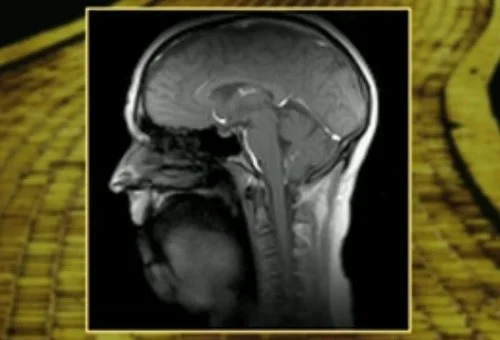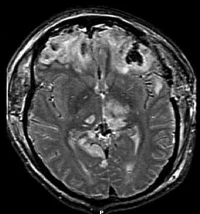With a new magnetic resonance imaging (MRI) technique, the vocal neuromuscular movements of singing and speaking can now be captured at 100 frames per second — a speed that is 10 times faster than standard MRI scanners. The novel technique, developed at the University of Illinois' Beckman Institute for Advanced Science and Technology, enabled researchers to illustrate how the hundreds of muscles in our neck, jaw, tongue, and lips work together to produce sound. This innovation is reported in the Journal Magnetic Resonance in Medicine.
"The fact that we can produce all sorts of sounds and we can sing is just amazing to me," says Aaron Johnson, affiliate faculty member in the Bioimaging Science and Technology Group at the Beckman Institute and assistant professor in speech and hearing science at Illinois. "Sounds are produced by the vibrations of just two little pieces of tissue. That's why I've devoted my whole life to studying it: I think it's just incredible."
The sound of the voice is created in the larynx, located in the neck. When we sing or speak, the vocal folds (ie, the two small pieces of tissue) come together and, as air passes over them, they vibrate, which produces sound.
After 10 years of working as a professional singer in Chicago choruses, Johnson's passion for vocal performance stemmed into research to understand the voice and its neuromuscular system, with a particular interest in the ageing voice. As he points out: "The neuromuscular system and larynx change and atrophy as we age, and this contributes to a lot of the deficits that we associate with the older voice, such as a weak, strained, or breathy voice."
Prof. Johnson wants to understand how these changes occur, and if interventions, like vocal training, can reverse these effects. "In order to do this, I need to look at how the muscles of the larynx move in real time," he says.
The dynamic imaging is especially useful in studying how fast the tongue is moving, along with other muscles in the head and neck used during speech and singing. "In order to capture the articulation movements, 100 frames per second is necessary, and that is what makes this technique incredible," Prof. Johnson adds.
The basis for the technique was developed by electrical and computer engineering professor Zhi-Pei Liang's group at the Beckman Institute. To combine the dynamic imaging with the audio, the researchers use a noise-cancelling fibre-optic microphone to pull out the voice, and then align the audio track with the imaging, according to Brad Sutton, technical director of the BIC and associate professor in bioengineering at Illinois.
Just in case you have not seen it, here is that video gone viral of "New Super-Fast MRI Technique: Singing 'If I Only Had a Brain'."
Source, video and image credit: Beckman Institute for Advanced Science and Technology
"The fact that we can produce all sorts of sounds and we can sing is just amazing to me," says Aaron Johnson, affiliate faculty member in the Bioimaging Science and Technology Group at the Beckman Institute and assistant professor in speech and hearing science at Illinois. "Sounds are produced by the vibrations of just two little pieces of tissue. That's why I've devoted my whole life to studying it: I think it's just incredible."
The sound of the voice is created in the larynx, located in the neck. When we sing or speak, the vocal folds (ie, the two small pieces of tissue) come together and, as air passes over them, they vibrate, which produces sound.
After 10 years of working as a professional singer in Chicago choruses, Johnson's passion for vocal performance stemmed into research to understand the voice and its neuromuscular system, with a particular interest in the ageing voice. As he points out: "The neuromuscular system and larynx change and atrophy as we age, and this contributes to a lot of the deficits that we associate with the older voice, such as a weak, strained, or breathy voice."
Prof. Johnson wants to understand how these changes occur, and if interventions, like vocal training, can reverse these effects. "In order to do this, I need to look at how the muscles of the larynx move in real time," he says.
The dynamic imaging is especially useful in studying how fast the tongue is moving, along with other muscles in the head and neck used during speech and singing. "In order to capture the articulation movements, 100 frames per second is necessary, and that is what makes this technique incredible," Prof. Johnson adds.
The basis for the technique was developed by electrical and computer engineering professor Zhi-Pei Liang's group at the Beckman Institute. To combine the dynamic imaging with the audio, the researchers use a noise-cancelling fibre-optic microphone to pull out the voice, and then align the audio track with the imaging, according to Brad Sutton, technical director of the BIC and associate professor in bioengineering at Illinois.
Just in case you have not seen it, here is that video gone viral of "New Super-Fast MRI Technique: Singing 'If I Only Had a Brain'."
Source, video and image credit: Beckman Institute for Advanced Science and Technology
References:
Liang ZP, Sutton BP et al. (2015) High-resolution dynamic speech imaging with joint low-rank and sparsity constraints. Magnetic Resonance in
Medicine, 2015; 73 (5): 1820 DOI: 10.1002/mrm.25302
Latest Articles
MRI, dynamic imaging, speech, sound, tongue, larynx
With a new magnetic resonance imaging (MRI) technique, the vocal neuromuscular movements of singing and speaking can now be captured at 100 frames per seco...










